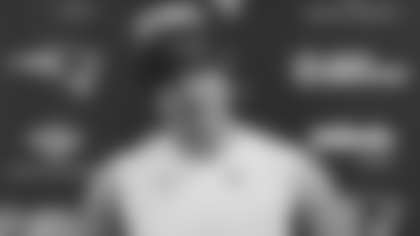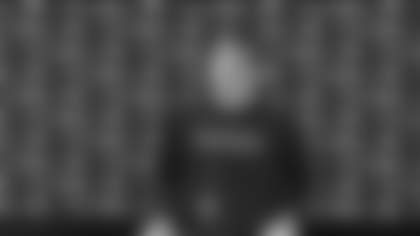NC: Good afternoon, good to see everybody. Just before we get started, I know last year when we got together, it was under more difficult circumstances – everything that had gone on with the marathon. I know it's kind of belated, but just kind of looking back a week ago, I know there's actually several people in here, a few people – Andy [Hart], Cecily [Faenza], Christy [Berkery] – that actually participated in the marathon, which is really neat, just to see the city and the way the region responded. It was kind of uplifting. I know it was a week ago, but I thought it would be appropriate just to make a commentary about that. From my perspective, just how neat it was to live in this region, to be in the city and see the support, the number of people that ran – 30,000 people, a million people watching the race. I failed to mention Berj [Najarian] as well, I guess I should give Berj some recognition. So, really cool, really neat. Obviously we're in a better situation than we were a year ago but I just thought it would be appropriate to acknowledge that. In addition to that, just a quick congratulations to the Hall of Fame finalists. Coach [Bill] Parcells, obviously he's left his mark on this organization and the league; a number of different franchises. Raymond Clayborn was a heck of a player for the organization and then Ty [Law], who probably had a little more experience, at least from my perspective, Ty was a heck of a player, probably still thinks he can go out there and cover people, just knowing his mentality and his competitiveness and his competitive nature. Congratulations to them and it will be interesting to see how that all unfolds. As it relates to the draft, we are obviously getting closer, about a week or so away, a week and change away. I just want to recognize [New England Patriots Director of College Scouting] Jon Robinson and his staff, just the amount of time and effort they've put in. it's an exhausting process that really goes back to this time a year ago in preparation for this draft. There are a lot of people that are involved and Jon and his staff do an outstanding job on a number of different levels. Certainly grateful for his efforts. There are a lot of people organizationally that are involved but Jon certainly has a big hand in what we do. This draft in particular, it's a good draft. Obviously there's a proliferation of underclassmen, I want to say the number is close to 100. They factor in, like they do every year. Certainly add a degree of depth to the draft. We're excited about the opportunity next week. We'll see how it all unfolds. I don't think there's really a set formula going into it, how we're going to approach it. We've hopefully put the work in and prepared and have the evaluations correct and then ultimately have to make the decision that we feel is best for our team in an effort to try to improve our team. This won't stop the team building process. There will be other opportunities for us to do it but with the roster at 65 right now, so there's probably 25 spots, give or take, that are available. The large bulk of those will probably come next week and I would say in the few weeks moving forward as well. That's where we are for now and for today and I'll take some questions and we'll open it up.
Q: What do you think is the defining characteristic of this draft?
NC: I'd say the underclassmen are a huge part of it. Obviously the largest number that we've had. There are certain positions, like there are every year, of strength. The receiver position is a deep group. There's a deep group of running backs. I'd say there's a deep group of defensive linemen that are different types of players. I think there are a lot of good football players that may not get drafted, which is the case every year, because just from a sheer number standpoint. You factor in all those different situations and you're going to evaluate the players the same way. It doesn't really affect the evaluation process. You maybe have to go back a little bit more on some of the underclassmen who have declared because there's less of a body of work that's available. But ultimately the process is the same. You go through it and really the first opportunity you have with those players comes a lot later because you really don't get to them until February which is the first time that they're actually available. You sort of have to fast forward everything and you really have February, March, April to get the information, make sure it's correct and then ultimately make the evaluation of the player. I think you've probably spent time evaluating them but as far as the depth and spending the one-on-one time with them, that's probably the thing that's probably different relative to the other players who you've had a little bit more opportunity and a little more exposure to.
Q: In your view, what's a good way to measure the success of a draft class?
NC: There's no exact science as it relates to this. You just try to find guys that fit your team. In the end, you just try to evaluate them for the role that they're going to have for your team. Inevitably some work out, some don't work out and you just have to go back and figure out where there may have been – why didn't it work? Was it the player? Did we overvalue a certain aspect of his athleticism? Of his actual ability? His skill level? There are a number of different metrics that you look at and it really, it's specific to the player, and everybody starts at a different point and their progression, each player is going to be different. It's a case-by-case basis. Ultimately you're trying to find players that fit your team. Not all players fit your team; some fit better than others. Hopefully you did the best you can to try to identify those players and then try to fit them in to your system. I would say it's really system specific to our team, realizing that there are a number of these players that are going to play in the NFL. We understand that and we respect that but in the end, we just have to figure out the players that fit a specific profile and have a defined role and try to project them in. in the end, there's still a projection element. There's a little bit of hit and miss there.
Q: How do you weigh the value, especially in the earlier rounds, of a player who is an immediate starter where you have a hole in the depth chart versus a player that may not have an immediate role but projects as a better player in the long term?
NC: You factor everything in. If you look at our team, just where we are today, if we had to go out there and play a game, we feel we could field a competitive team. You try to go through and in the end, you try to find the players that you feel fit best for your team regardless of their position. If we had to go out there and play today, we have a number of players – now we're only four or five days into the offseason program so you're really not sure what to expect. You have some inclination but different players are going to progress at different paces and different speed. You can say, 'Well, this player is going to come in and do 'X'' Well, ultimately the player's performance is going to determine what his role is. You may have an idea of, 'This is how we envision the player,' but if he can't come in and actually do that then in the end, the competition we kind of let that unfold itself. Player's performance is ultimately going to dictate how big of a role that is. Whether that's early or whether that's late, that's going to be based on his performance relative to the other players at his position.
Q: Do you want to have a blend to your draft class of how ready to play they are?
NC: I think you just have to have a balance of players and realizing that different players are going to have different roles, there's no exact, definitive formula saying 'We need 'X', we need 'Y', we need 'Z'.' I think we look at it and can say, 'OK, once we go through the board and do the evaluation and stack it positionally, say OK, who is the best player for our team given what else is out there on the board right now?' if a player comes along sooner rather than later, then great. If it takes him a little bit further, we understand that too. Ultimately we're trying to find the best 53 that fit our team so that ultimately in September when we go out there ready to play, we have that group of players. Realizing that there might be another group of players that aren't on the roster but at some point, like the Josh Klines, who start the season, they come in, they're not drafted, they work hard, they start the year on the practice squad and ultimately they put themselves in position where they take advantage of their opportunity. There are cases like that. I wouldn't say there's one set formula. I think you just have to figure out what's best for your situation. Just as sit here today realizing that could change at any given point in time.
Q: Is there a line you won't cross with players who have character issues? And if so, has that line moved after some of things you've been through?
NC: I think the players, really, you look at the entire body of work when you create the profile on a player. There are a multitude of metrics that go into that: the player's performance, their football character, which is separate from their off the field character, if you will. There are a number of things that go into the profile of the player: their medical history, their performance, their play history. You're really trying to take all that information and say in the end, here's the profile of that player and then if we feel comfortable organizationally with that player then we make the decision. If we don't feel comfortable, then we move on to the next player. Each player is going to have their own package and we understand that and we realize that. Ultimately we have to make the decision that we feel is best. We spend a lot of time on that and we try to make the best decision we can for us at the time.
Q: How important is the interview process and what are you trying to gauge when meeting with a player?
NC: A lot of things. The interview process in and of itself, you touch on a number of different things. It's their personal situation, their background, the football component of it I'd say is significant. As an example, let's say you have a player that you talk to at an all-star game. So you have one exposure there with someone from your personnel department. Then you're at the combine and you have another dialogue with them, whether it's a position coach or Bill [Belichick] or myself and then you go out in the spring and you work them out. Let's say you try to teach them your system, install some of your system, go through their role, 'OK, here is this play, here is your assignment,' and then you have that same player and you bring him to your facility and you're looking at his recall. 'OK, how did he handle the information that we gave him? Is the same story that he gave one coach, is it different from [another]?' You have really a system of checks and balances. It's not one 15-minute combine interview where you say, 'OK, we've got it all straight.' That's really just an introduction. In some cases, you've had some exposure at different points along the way. It's very extensive, it's very exhausting and it touches on a number of different areas and really what we're trying to do is try to figure out within the confines of this building, will he be able to handle the demands of our program on a day to day basis. Really that's what you're trying to get to. You try to dig in as best you can, as much as you can, on a variety of different topics and areas. The football component is a huge part of that process, just in terms of their learning capacity, in terms of the ability to actually play within your system. There's definitely a lot that goes into it.
Q: Have you had any more interaction with the top quarterbacks this year than in the past?
NC: I think this year is really no different. I think what we try to do is take each position and really try to know top to bottom as thoroughly as we can, as many players at that position. Historically we spend a lot of time this time of the year, whether it's players that we bring to the stadium, that we work out on campus. The process, I would say, is really no different this year than it was in years past. It's all with the idea of trying to gain as much information about that position group top to bottom so that when you're sitting up there looking at 'X' amount of players, you have a good baseline of information and it's not, 'Well, we haven't spent enough time.' The answer isn't, 'I don't know, we haven't spent enough time with him.' Look, we can't get everybody but you try to identify and earmark 'X' number of players and then we try to get as much information as we can so that we're prepared in the event that we have to make a decision at some point along the way.
Q: One theory is that you could get information on a quarterback if you face him the next year. Is that overstated in your opinion or could there be value to that?
NC: When you talk to a player, I would just say generally speaking, when you talk to a player that's played at whatever school, you try to go through and say, 'OK, what have you done offensively or defensively? Your role, your position, what's your assignment?' a lot of time, when you're watching the film you really don't know what they're asked to do. You're trying to actually have the player teach you what's going on here to see if he can learn anything. Once a player gets into the NFL, whatever he's done in college or whatever he's learned or whatever system that he's played in, it's really irrelevant. Now they're moving forward, they're going to be with another team so it's going to be specific to that team. If a player is playing, like let's say he went to Illinois, just to pick a school. So you get some information about what they did at Illinois and then he's in the league playing for Buffalo. Does it really matter what he did defensively at Illinois? I don't know. In the end, you want to, when you meet with a player, you're trying to look at his mental acumen and his capacity to learn. How does he process information? How does he recall? Does he need repetitions? Is he more of a visual learner? I think you're looking more at their method of learning as opposed to what they actually are learning, if that makes any sense.
Q: Why is the wide receiver traditionally so tough to project from college to the NFL? Does tight end get lumped into that now?
NC: To a certain extent. The receiver position in general, there are so many more multiples that are involved which a lot of these players don't see. One of things that's come into play is the use of the high frequency, high tempo offense. So, you run a play, you sprint to the line and they get a play off within five to 10 seconds. So the player stays in one spot, chances are they are repeating the same play. The complexity of coverages defensively I would say is minimal because you can't have a lot of calls defensively to combat the pace and the speed of what a team is doing offensively. There are definitely more multiples coverage wise that they're going to see on a week to week basis. A lot of the time, the proximity of the defender between himself and the receiver. I would say the number of teams that actually play at the line of scrimmage defensively on a consistent play by play basis is very small. The majority of the time, the defender is five, six, seven yards off so he has free access into the defense so there's less that he has to deal with at the line of scrimmage. Now you fast forward. I would say the majority of the time you're going to have a defender in your face at the line of scrimmage on the perimeter or in the slot as well. Inside there are some different components that go into play. There's just more multiples, there's more variety of coverages, there's more disguise. The ability to think quickly and react to what you see, some can do that better than others from the sheer fact they haven't been asked to do it. The tight end position, it's different but some of these tight ends, they're detached from the line of scrimmage 95, 100 percent of the snaps. Well the likelihood of that player actually doing that on a 70-snap game basis is minimal. He's going to be on the line of scrimmage, maybe he's detached or flexed out slightly, maybe he's off the line of scrimmage in the backfield or in the wing position. I think there's just more of a multitude, more multiples that those players forced to deal with at those positions as it relates really to coverage, adjustments, etcetera. It takes a little bit of time to understand that and learn that, just the simplicity of some of the colleges. That's what they're dealing with on a weekly basis. We can't change that. But what you are hopefully able to do is project and say based on his physical attributes he may be able to do it or he may have a hard time doing it or mentally he's a little bit of a slower processor so coverage… So, those are some of things that come into play at those two positions.
Q: Organizationally do you have to think about a succession plan for Tom Brady now or is that still years away?
NC: I think right now our focus is just on the draft and trying to improve our team. We'll go through the offseason program once we have the players that are here. I would say we're focused on the short-term. Like I said, we just started the offseason program. We'll see how our players, where they are physically once we get on the field, once we start practicing. Right now, I think our focus is on the draft and just trying to improve our football team.
Q: In terms of drafting a quarterback to succeed Tom, would that be something you would focus on now?
NC: I would say we're focused on improving our football team in whatever capacity we can do. We'll always consider that.
Q: After drafting two receivers last year, would it make you hesitant to go for that position again?
NC: It's a good question. I think what you don't want to do is pass on a good football regardless of your circumstances. We've talked about this a little bit in years past. When we drafted Nate [Solder], with Matt [Light], we felt like he would be coming back and we had Sebastian [Vollmer]. When we drafted Nate, at the time did we necessarily need to draft that player? Maybe, maybe not. But we felt like that was player that we had conviction about. We felt good about the player and we'd figure out a way to utilize him. You never want to pass up a player. Look, if they are equal value maybe you go to a different position but if there is a good football player and he's head and shoulders above the rest then internally we just have to make that decision. Btu you don't want to pass on a player just because he has a position where there might be numbers or volume or whatever the case may be.
Q: Understanding that the process doesn't change, are these extra two weeks helpful or excessive? What is your opinion on the extra time?
NC: I think it's really how you utilize it. I would say we're not really doing anything differently. Has it given us a few more weeks? Maybe, but I would say just generally speaking, it really hasn't had much of an impact. Maybe it gave Bill [Belichick] a chance to run the half marathon over the weekend which maybe he didn't mind. Whenever the draft is, whenever they tell us it is, then we'll be ready to go for it.
Q: How do you envision Brandon Browner, Brandon LaFell and Darrelle Revis helping you out this season?
NC: Any new player that we bring in, they start kind of at the same level. We'll indoctrinate them into our program. Like I said, this is the sixth day of the offseason program. There are a lot of players that have been here. Once we get on the field and start working as a group we'll have a better idea. We think those players can help us and we'll see how they do once we get rolling with the rest of the group.
Q: Is a guy like Julian Edelman an example of things going well in the draft process?
NC: I think Julian really has earned everything that he's received over the course of his career. There's a guy who had never caught a punt, never caught a pass until he arrived here. It's really a credit to Julian, it's a credit to the coaches for continuing to work with him. He deserves a lot of the credit but you try to find players that have certain qualities and criteria and then when you bring them into your program, hopefully they continue to improve and they take the coaching on a year to year basis. When they have an opportunity to perform and they go out there and perform. I think that's what you hope to do with players when you bring them in. It doesn't always work that way but hopefully that's the idea. You just try to bring players in, teach them your system, get them to improve and then however far that goes will be a product of their efforts and what they do. Julian has put a lot of time in and he deserves whatever he's received.
Q: How much of this is a poker game between you and other executives around the league right now?
NC: I'd say it's a pretty big one. There's so much information that's floated out there. The reality is, nobody really knows other than their respective teams. There's a lot of information that's out there. I think you just have to be careful of how much stock you actually put into it. You try to make your best guess of what you anticipate a team may or may not do but I'd say there's probably a lot of noise that's out there and nobody really knows until the actual draft starts and the team picks. I think that's the truth.
Q: As far as the safety position goes for the Patriots, how much do you guys value having two guys that have distinct responsibilities – maybe that traditional free versus strong safety position? Is that important or do we make too much out of that?
NC: I think having versatile players that can do multiple things is important and how you deploy those players. Ultimately you try to play to a player's strengths so whatever a player does well you try to put them in a position schematically where they can utilize those skills. We've had corners that have played safety, safeties that have played safety. That position, there are a lot of things that go into it. There's a space game, there's a tackling game, there's instinctiveness, ball skills, all those types of things, they are applicable not only to the safety position but the corner position as well. Some corners actually look like safeties, some safeties look like corners. I think the defensive back group in general, having the degree of position versatility is certainly helpful, especially when you're playing certain teams on a week to week basis, it doesn't force you to make wholesale changes – 'Well, if this guy is in the game, we have to put this guy in the game.' Having guys that are multiple that might be utilized in multiple roles, there is certainly value in that.







































